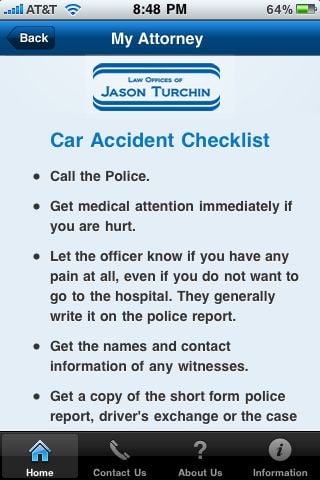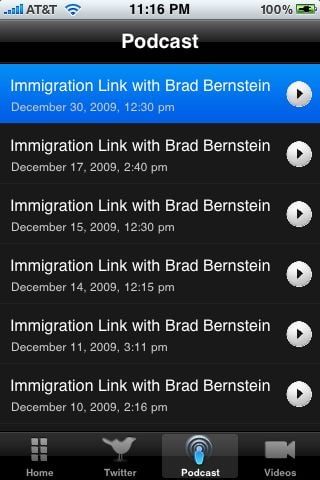 I’ve never done a formal review of the Facebook iPhone app on iPhone J.D. even though it is one of the most useful apps on the iPhone and a handy way for attorneys to keep in touch with friends from high school, college, law school and elsewhere. You never know, one of them may be your next client or co-counsel, plus there are other reasons that lawyers should consider using Facebook. (Although in Florida and perhaps elsewhere, think twice before you send a friend request to a judge.)
I’ve never done a formal review of the Facebook iPhone app on iPhone J.D. even though it is one of the most useful apps on the iPhone and a handy way for attorneys to keep in touch with friends from high school, college, law school and elsewhere. You never know, one of them may be your next client or co-counsel, plus there are other reasons that lawyers should consider using Facebook. (Although in Florida and perhaps elsewhere, think twice before you send a friend request to a judge.)
In this past, I’ve resisted publishing a review of the Facebook app because, frankly, I suspect that every iPhone owner who uses Facebook already has and uses the free app. If you don’t, you are really missing out. In many ways, I like the iPhone interface even better than the desktop web browser interface because it is clean and focused. Plus, you get none of those annoying ads on the side.
The main screen on the app gives you nine buttons so you can easily view your Wall or your News Feed, and on a second screen you can store shortcuts to your favorite Facebook friends.
I am writing about this app today to mention the new version 3.1 that came out yesterday. The update adds two new features. First, the app now supports push notifications. In the main iPhone Settings app you can control the items for which you will receive push notifications. For now, I have all seven options turned on, but as the novelty wears off I will probably start to selectively turn some off. For example, with Messages notifications turned on, if someone sends you a Message (a direct e-mail) on Facebook, you will receive a pop-up notification on the iPhone. (The Facebook push notifications do not make a sound, vibrate the phone, or add any icon badge updates, even if you have those features enabled for push notifications.) In my experience, this service worked very quickly, typically providing a notification on the iPhone within a second or two of a message being sent.
If you are not someone who spends a lot of time on Facebook, enabling push notifications is a good way to make sure that you know when something relevant to you is happening on Facebook. And even if you are a frequent Facebook user, now you can be even more timely.
The second nice improvement in the 3.1 update is that the Facebook app can now sync with your contacts. For now, this feature only does two things. If you enable contact syncing, Facebook will look at the names and phone numbers of people in your Contacts on your iPhone. If it finds an exact match with one of your Facebook friends, then the app will add two things to the entry in your Contacts. First, it will add the person’s Facebook picture to your Contacts entry. You can tell the app not to replace a photo in your Contacts if you
already have one, and that way it just fills in missing photos. (A few people have reported on the Internet that this didn’t work for them, but for me it did a fine job of respecting entries for which I already assigned a picture.) [UPDATE: As Jared points out in the Comments, Facebook quickly released a 3.1.1 update to address syncing bugs.]
Second, it will add a home page entry to the Contact in the format of fb://profile/1234567890. If you tap on that in the Contacts app on your iPhone, it will launch the Facebook app and show you that person’s profile. I have seen people post on the Internet, but have not been able to confirm myself, that if a phone number matches then the sync will occur even if the names are not exact matches. Otherwise, the name has to match exactly, so if one of your friends uses a nickname on Facebook, or if you use a nickname in your Contacts, the sync for that friend won’t work.
Facebook doesn’t add your iPhone Contacts to Facebook, doesn’t add your Facebook contacts to Contacts, or anything like that. I like this conservative approach, although perhaps in the future they will add more syncing options. For example, some people provide a phone number on their Facebook profile page, and it would be useful to have the app automatically download that into your Contacts entry for the person if you don’t already have it. But even for now, it is nice to have more profile pictures added to my Contacts automatically without having to use a third party program to accomplish this task. When a friend calls me on my iPhone, I like having a picture come up, which my mind processes even faster than looking at a name.
The person at Facebook who developed the originally iPhone app left the project in late 2009, so it is nice to see that Facebook is still developing its app and adding new features. I’m already looking forward to the next update.



























 CNBC is planning to show two Apple-related movies. First, CNBC is airing the great movie
CNBC is planning to show two Apple-related movies. First, CNBC is airing the great movie 



























